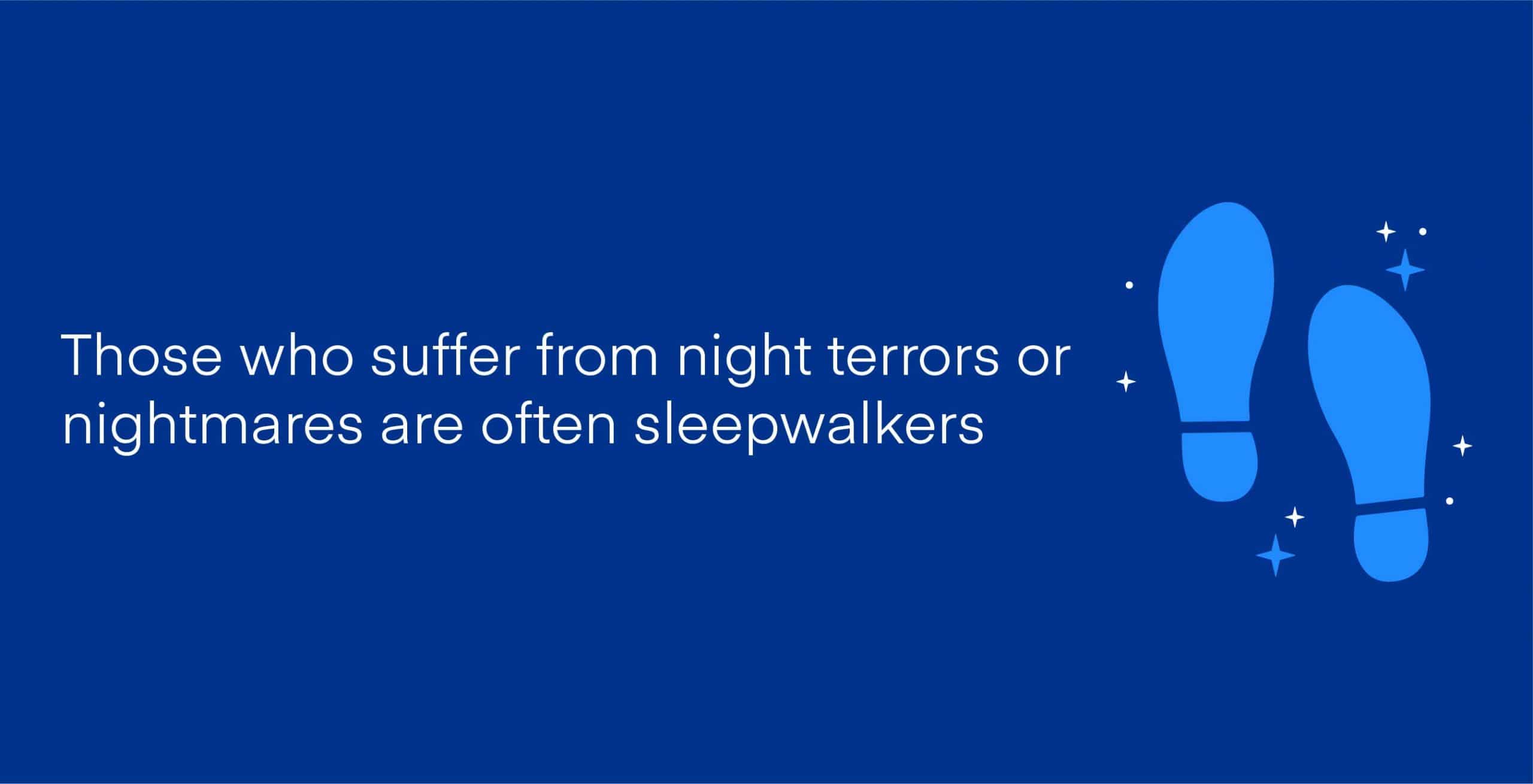Key Takeaways
- Difference Between Nightmares and Night Terrors: Nightmares are scary dreams that can often be linked to stressful situations or negative experiences from daily life. After waking, people can recall them. Night terrors, on the other hand, are challenging to wake someone from, and individuals who experience them usually don’t remember the episodes the next morning.
- Prevalence and Impact: Nightmares are relatively common, with around 50-80% of adults experiencing them occasionally. Night terrors, on the other hand, are more common in children, with approximately 40% of kids having sleep terrors, although they tend to decrease with age. Night terrors can cause distress and physical symptoms like sweating, rapid breathing, and confusion.
- Prevention and Treatment: To prevent and treat nightmares and night terrors, establish better sleep hygiene and address underlying stress and anxiety. A consistent bedtime routine, adequate sleep, and making the sleeping environment safe are all important steps. Cognitive-behavioral therapy (CBT) and other therapeutic interventions can help address anxiety-related sleep disturbances.
Most of us experience bad dreams every once in a while, but chronic nightmares or night terrors can really start to disrupt sleep patterns, and in turn, affect our overall health. Maybe you’ve been experiencing frequent recurring nightmares related to recent stress or trauma, or perhaps the nightmares seem more realistic—almost like you’re awake when they’re occurring.
The primary difference between the two Verified Source National Library of Medicine (NIH) World’s largest medical library, making biomedical data and information more accessible. View source is that nightmares can be recalled, sleep terrors cannot. Whether you’re plagued with night terrors or nightmares, the treatment for both problems tends to overlap: better sleep hygiene and stress management.
What Are Nightmares?
Around 50-80 percent of adults experience nightmares occasionally. However, once nightmares begin to significantly disrupt sleep, this leads to “nightmare disorder”—only about 2-8 percent of people suffer from a nightmare disorder. According to the Mayo Clinic, Verified Source Mayo Clinic Ranked #1 hospital by U.S. News & World Report and one of the most trusted medical institutions in the world. The staff is committed to integrated patient care, education, and research. View source nightmare disorder is marked by fatigue, behavioral problems, especially surrounding bedtime or sleep, and poor memory.
Nightmares are scary dreams often drawing on stressful situations or negative experiences from your daily life; often, in a nightmare, the negative aspects are exaggerated, causing you to wake up in a panic. Sometimes nightmares are a manifestation of some inner turmoil or stress you’re experiencing, and so to address it, you can focus on mental health and stress relief.
Nightmares Verified Source National Library of Medicine (NIH) World’s largest medical library, making biomedical data and information more accessible. View source are often linked to PTSD, or post-traumatic stress disorder. Other nightmare triggers include other sleep disorders, like Restless Legs Syndrome, anxiety, and poor sleep—yes, poor sleep can lead to nightmares, which can lead to even less sleep—creating a vicious cycle. Nightmares occur during the REM, or rapid eye movement portion of the sleep cycle; this is the stage when we are most likely to be aroused from sleep. We’re more likely to remember nightmares, too, just like other recurring dreams.Night terrors, on the other hand, are not that easy to wake somebody from, and those who suffer from episodes often don’t remember them happening the next morning.
What Are Night Terrors?
Night terrors are more prevalent in children than adults—about 40 percent Verified Source Mayo Clinic Ranked #1 hospital by U.S. News & World Report and one of the most trusted medical institutions in the world. The staff is committed to integrated patient care, education, and research. View source of kids have sleep terrors, but they tend to taper off with age (usually by teenage years). Night terrors peak at age six and often begin at preschool age. Despite their similar names, night terrors are a little different than nightmares because of when they occur during the sleep cycle.
“About 1 to 6.5% of children experience night or sleep terrors,” explains Dr. Nayantara Santhi. “They usually occur in children between 4 and 12 years of age, with a peak between 5 and 7 years of age. The exact cause is not known but currently various developmental, environmental, organic, psychological, and genetic factors have been identified as potential causes.”
“Sleep terrors tend to occur within the first three hours of the major sleep episode, during arousal from stage three sleep or deep sleep. However the good news is that most children outgrow this condition by adolescence.”
Nightmares happen during REM sleep, so they tend to gradually build up and then end, just like a dream would. They can cause distress to the sleeper, but usually not to an extreme degree (unless they have nightmare disorder). Night terrors, on the other hand, occur during non-REM, or deep, slow-wave sleep. As a result, they are much harder to wake up from and can cause the sleeper to think they are still sleeping when they are awake, or vice versa. This can sometimes lead to injury or sleep paralysis.
Night terrors are often accompanied by sweating, rapid breathing, fast heart rate, dilated pupils, confusion, or thrashing limbs. They don’t usually cause for concern unless they begin to frequently disrupt sleep or lead to physical injury. Other parasomnias linked to night terrors include sleepwalking, sleep apnea, and sleep deprivation.
How to Prevent and Treat Nightmares and Night Terrors
Sometimes it can be hard to tell whether you are experiencing night terrors or nightmares because the symptoms often overlap. However, you can usually tell the difference by the time of day you experience them—night terrors happen during the first third of sleep, and nightmares happen during REM sleep, or towards the end of sleep. But a hallmark of night terrors is that the sleeper usually doesn’t remember having them, so if nobody else witnessed your night terror episode, how do you know you even had one?
If you’re waking up with a racing heart or you experience related symptoms like sleepwalking, poor sleep, and anxiety surrounding bedtime, you could be experiencing night terrors. Some sleep medicines can cause nightmares and night terrors, so take caution when you use these to treat sleep. We recommend establishing better sleep hygiene habits first before you resort to medication.
Stick to a Bedtime Routine
Sleep problems are often caused by poor sleep habits. The first thing you can do to get better sleep is to establish and stick to a consistent bedtime routine, even on the weekends. Take a calming warm bath before bed—studies show implementing this practice 1-2 hours before bed can improve sleep. Dim the lights in your room before bed and make sure your room is only used for sleep—no TV or other bright screens.
Adults need 7-9 hours of sleep every night, so prioritize your day to ensure you get as close to that amount as possible. Remember sleep deprivation can cause nightmares and night terrors as well as make them worse.
To treat your child’s night terrors, you can implement these same strategies for better sleep. If you find these methods aren’t working, consult your child’s pediatrician. There may be another underlying issue disrupting their sleep that goes beyond a better nighttime routine and enough sleep.
Make Your Room Safe for Sleep

Those who suffer from night terrors or nightmares are often sleepwalkers, so they need to make sure they don’t trip or fall in the night. Try sleeping on the floor, set an alarm, or lock your bedroom door. If you live with family members or friends, you can ask them to make sure you stay safe while sleeping as well. Remember once someone is in the deepest stage of sleep and experiencing a night terror, it’s harder to wake them up.
Other Methods
If your sleep disturbances are marked by anxiety, you may have success with cognitive-behavioral therapy (CBT), a series of treatments meant to target the underlying issues disrupting sleep.
Some sleep studies can uncover other sleep issues and patterns you may be struggling with; others suffering from parasomnias have found journaling before bed can help them achieve more restful sleep.
Sweet Dreams
If you or your child are experiencing nightmares or night terrors, you don’t have to suffer forever. Start with a healthier bedtime routine—one that is consistent and conducive to healthy sleep—and address your anxiety and stress head-on. Most likely, your sleep interruptions will begin to decrease.
About the author
McKenzie Hyde is a Certified Sleep Science Coach and a full-time writer specializing in sleep health and the mattress industry. With a Master of Arts degree in literature and writing from Utah State University, McKenzie combines her passion for writing with her in-depth knowledge of sleep science. Her articles cover a wide range of topics, including best sleep practices for students, the consequences of sleep deprivation, and choosing the right mattress for back pain relief. McKenzie's dedication to delivering accurate and informative content makes her a valuable contributor to the field of sleep health.
View all posts





